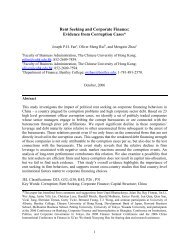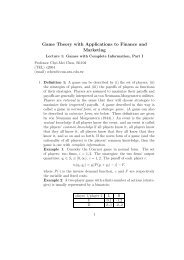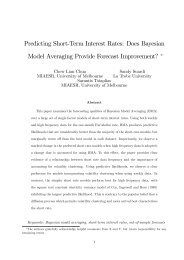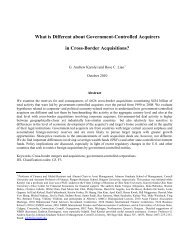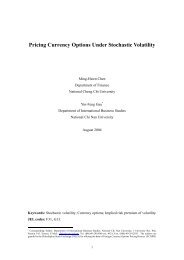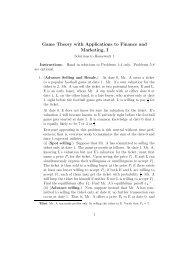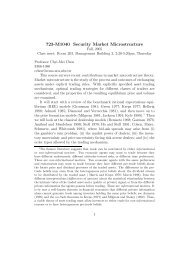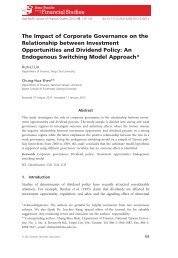Game Theory with Applications to Finance and Marketing
Game Theory with Applications to Finance and Marketing
Game Theory with Applications to Finance and Marketing
You also want an ePaper? Increase the reach of your titles
YUMPU automatically turns print PDFs into web optimized ePapers that Google loves.
7. Definition 11. (Bernheim, Peleg, <strong>and</strong> Whins<strong>to</strong>n, 1987) Suppose that<br />
we are given an I-person finite strategic game Γ. Let J be the set of<br />
all feasible coalitions.<br />
(i) If I = 1, then a profile σ is a coalition-proof equilibrium if <strong>and</strong> only<br />
if u 1 (σ) ≥ u 1 (σ ′ ) for all σ ′ ∈ Σ.<br />
(ii) Suppose I ≥ 2 <strong>and</strong> coalition-proof equilibrium (CPE) has been<br />
defined for all n-person finite strategic game <strong>with</strong> n ≤ I − 1. A profile<br />
σ is self-enforcing for the game Γ if for all J ∈ J <strong>with</strong> #(J) ≤ I − 1,<br />
σ J is a coalition-proof equilibrium in the game Γ/σ −J (which is the<br />
#(J)-person strategic game where everything is as in Γ except that<br />
players in −J are restricted <strong>to</strong> play σ −J ). A coalition-proof equilibrium<br />
is a self-enforcing profile σ such that no other self-enforcing profiles σ ′<br />
can simultaneously provide each <strong>and</strong> every player in Γ a strictly higher<br />
payoff than σ.<br />
Thus when I = 1, CPE requires only the best response property. By<br />
definition, a self-enforcing profile must be a Nash equilibrium profile for<br />
Γ, a CPE must be a Nash equilibrium which is not strictly Pare<strong>to</strong> dominated<br />
by other Nash equilibria. In fact, for two-person finite strategic<br />
games, self-enforcing profiles coincide <strong>with</strong> NE profiles, <strong>and</strong> CPE are<br />
equivalent <strong>to</strong> the set of NE’s which are not Pare<strong>to</strong> strictly dominated.<br />
However, for I ≥ 3, no inclusion relationships can be established between<br />
the two. Apparently, a strong equilibrium, if it exists, must be<br />
a CPE.<br />
With these definitions <strong>and</strong> discussions in mind, we now consider two<br />
problems. First, consider three players A, B, <strong>and</strong> C, who are <strong>to</strong> divide<br />
one dollar, <strong>and</strong> each of them must choose a point in the two-dimensional<br />
simplex {(a, b, c) ∈ R 3 + : a + b + c = 1}. The three players move<br />
simultaneously, <strong>and</strong> if at least two of them pick the same point (a, b, c),<br />
then this point will be implemented, in the sense that a, b, <strong>and</strong> c will<br />
be the payoffs of A, B, <strong>and</strong> C respectively; or else, the dollar will<br />
be destroyed. We claim that this game has no CPE’s. To see this,<br />
suppose instead that there were a CPE (denoted σ) in which the players<br />
get expected payoffs (a, b, c), where <strong>with</strong>out loss of generality, a > 0.<br />
Given σ 1 , players 2 <strong>and</strong> 3 could jointly deviate in the game Γ/σ 1 by<br />
announcing simultaneously (0, a +b, a +c), for example, thereby having<br />
2 2<br />
the latter implemented (but this joint deviation must form a Nash<br />
7



